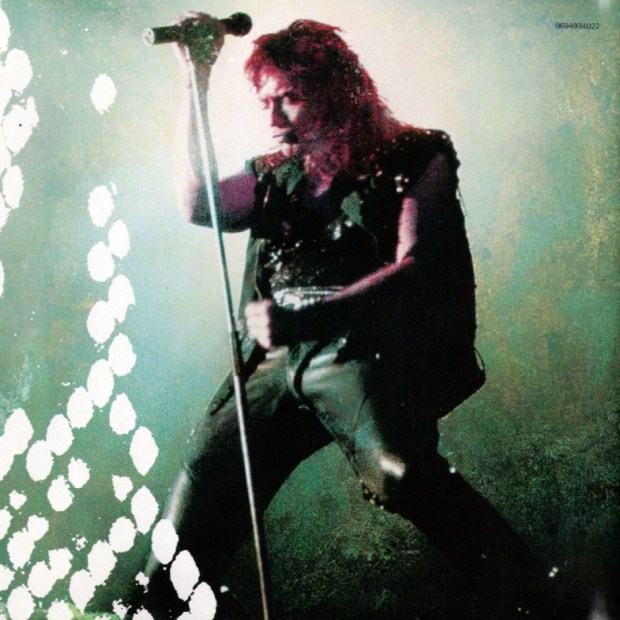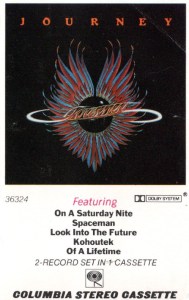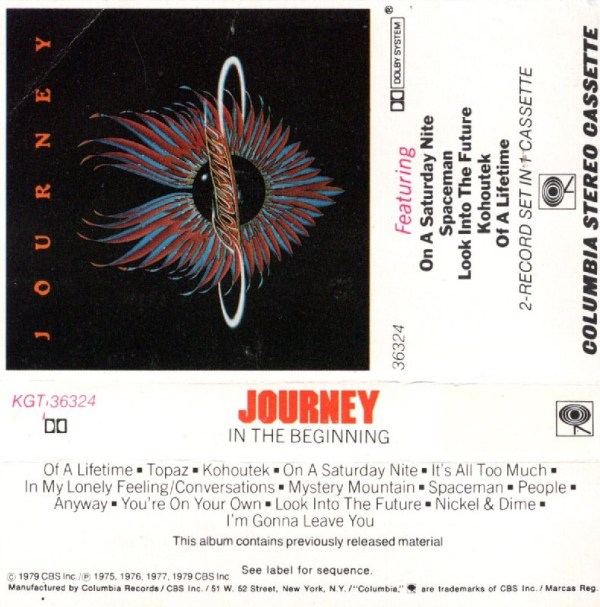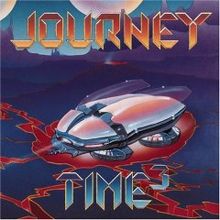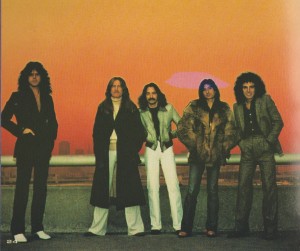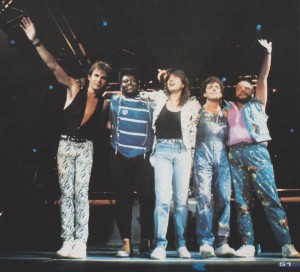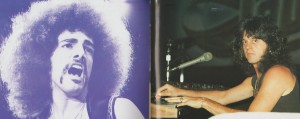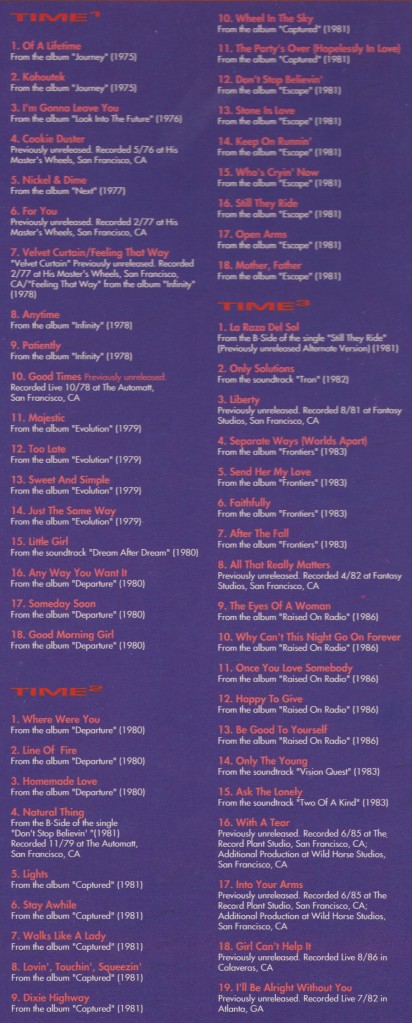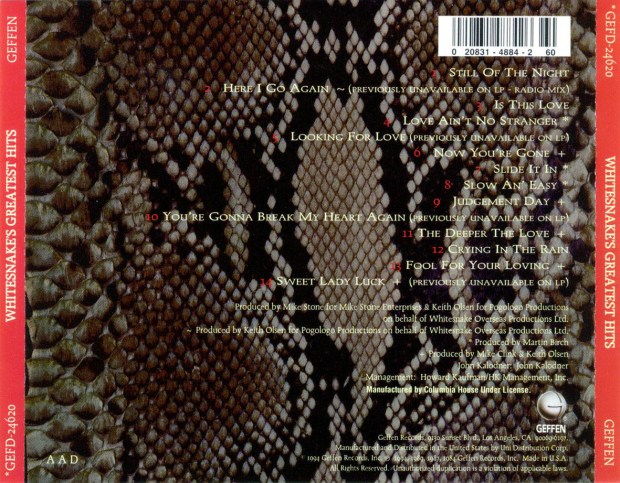 WHITESNAKE – 1987 (30th Anniversary Edition Rhino box set)
WHITESNAKE – 1987 (30th Anniversary Edition Rhino box set)
Back when I reviewed the original “Deluxe” edition of Whitesnake’s 1987, I said, “Great album, but this reissue could have been so much better.” And so here we are.
Let’s get right down to it. You already know the story of Whitesnake 1987 or you wouldn’t be here.
The main feature is the 2017 remaster of 1987, which actually sounds pretty great. In this day and age, if you’re seeking the warmth of a vintage vinyl experience, you can go and have that experience for far less money than this box set costs. For a compact disc, this might be as good as we’ve gotten so far. If you look at the Audacity waveforms below, you can see the 2017 remaster (top) has roughly the same levels as a previous one from Whitesnake Gold.
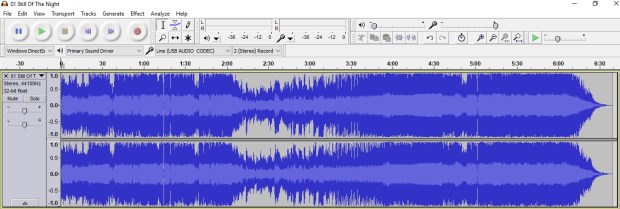
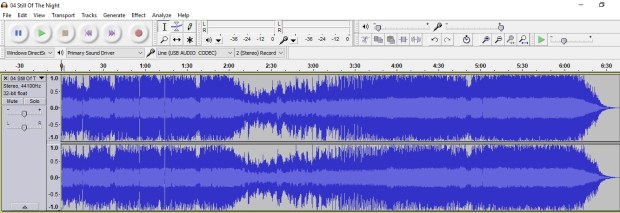
I’m still hanging on to my original UK version of 1987, but for compact disc, this is probably it.
 David Coverdale wanted to adapt Whitesnake to the 1980s with this album, and this lineup with John Sykes, Neil Murray, and new drummer Aynsley Dunbar was certainly able to deliver. The album was always loud, especially compared to their 70s output. Sykes provided the squeals that the kids wanted. David was back in top voice. The album they delivered is legendary for how it changed Whitesnake’s fortunes.
David Coverdale wanted to adapt Whitesnake to the 1980s with this album, and this lineup with John Sykes, Neil Murray, and new drummer Aynsley Dunbar was certainly able to deliver. The album was always loud, especially compared to their 70s output. Sykes provided the squeals that the kids wanted. David was back in top voice. The album they delivered is legendary for how it changed Whitesnake’s fortunes.
The running order on this box set is not the original UK or US, but the combined running order as used on the previous 20th anniversary edition.
“Still of the Night” blows the doors in, a tornado in the night, mighty and sexy too. Whitesnake had never been this aggressive before, but “Give Me All Your Love” lulls the listener back to something easier to digest on first listen. “Give Me All Your Love” was a successful single because it’s melodic pop rock with guitars. But then the band scorch again with “Bad Boys”, top speed right into your daughter’s headphones! Whether it was Aynsley Dunbar or just the songs that they wrote, the pace is high gear.
“Is This Love”, a song that David was writing with Tina Turner in mind, was another massive hit. John Kolodner (John Kolodner) insisted that they keep it for themselves, and he was right as he often was. For a big 80s ballad, “Is This Love” really was perfect. It tends to work better in a stripped back arrangement, since the original is so specifically tailored to that era. Still, Sykes’ solo on it has to be one of his best.
Speaking of hits, “Here I Go Again” is the one that Sykes didn’t want to do, and look what happened. That humble pie probably tasted no good to Sykes when he found himself fired by Coverdale after the album was completed. His replacement, Adrian Vandenberg (Vandenberg) actually played the guitar solo, so dissatisfied was Coverdale with the one Sykes produced. “Here I Go Again” was of course a minor hit from Saints & Sinners, but deserving of a second shot in America with production more suited to their tastes. Don Airey on keyboards; though Whitesnake did without an official keyboardist this time.
“Straight For the Heart” is a great also-ran that perhaps could have been another single if they kept trottin’ them out instead of stopping at four. High speed but with incredible hooks, it’s impossible not to like. “Looking For Love” is the second ballad, but actually originally unreleased in the US. It’s toned down from the style of “Is This Love”, and Neil Murray’s bass is pronounced. He was a huge part of the groove on this album, if you really settle in and listen to the rhythm section. His bass has a certain “bop” to it. “Children of the Night” returns the tempo to allegro and the lyrics to dirty. I can’t imagine too many fathers of the 80s wanted their daughters to go to the Whitesnake concert if they heard David cooing, “Don’t run for cover, I’m gonna show you what I’ve learned, just come a little closer, come on an’ get your fingers burned.” Another UK exclusive, “You’re Gonna Break My Heart Again” cools it down slightly, but that Sykes riff is hot like a torch!
“Crying in the Rain” is held back to second-last in this running order, even though it opened the US album. Another re-recording, “Crying in the Rain” was suggested by Kolodner because he knew Sykes could give it that massive blues rock sound that it had in the live setting. Again, he was right. “Crying in the Rain” is massive — perhaps the most sheerly heavy piece of rock that Whitesnake ever dug up. Finally the CD closes with the last ballad, “Don’t Turn Away”, which closed the US version. It’s a fine song indeed, and a really good vibe on which to end Whitesnake 1987.
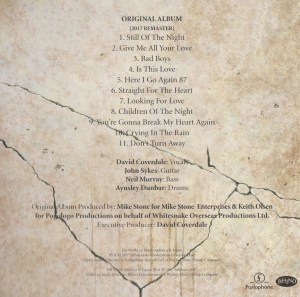
 The second CD in this set is called Snakeskin Boots: Live on Tour 1987-1988. Presumably, these are recordings from throughout the tour, assembled into a CD-length running order. The “boots” in the title implies bootleg quality, but it certainly sounds better than that. Soundboards maybe?
The second CD in this set is called Snakeskin Boots: Live on Tour 1987-1988. Presumably, these are recordings from throughout the tour, assembled into a CD-length running order. The “boots” in the title implies bootleg quality, but it certainly sounds better than that. Soundboards maybe?
The studio lineup of Whitesnake dissolved and David got Vandenberg in, followed by Vivian Campbell (Dio) and the rhythm section of Rudy Sarzo and Tommy Aldridge (Ozzy Osbourne). This new lineup was not based in the whiskey blues of the old band(s), but in the flashy stylings of the 1980s. Vivian and Vandenberg were both capable of shredding your brain. That’s generally how they do it on these recordings. Opening with “Bad Boys”, the manic tempo is maintained while the guitars reach for the stratosphere.
Sounds like it was a hell of a show, rolling into the groove of “Slide it In” and “Slow An’ Easy”, and the good news is the 1987 band can play the 1984 songs too. David Coverdale is the ringmaster, the veteran, confident and in prime voice. All the songs are from either 1987 or Slide it In, with only one exception: the slow blues “Ain’t No Love in the Heart of the City” from the original 1978 Snakebite EP. Sounds like Vivian Campbell accompanying David on this slow, classy blues. No Deep Purple in the set; but my old pal Rob Vuckovich once said he went to the Toronto show on this tour bearing a flag that said “PLAY PURPLE”. He also claimed David acknowledged it by saying, “We’re not playing any of that!”
“Here I Go Again” comes early on the CD, fourth in line, and it’s excellent. “Guilty of Love” is a nice surprise, and “Love Ain’t No Stranger” is more than welcome at the party. “Is This Love” is well received, and works well in the live setting without too much extra production. Adrian can’t top the Sykes solo, though he gets within very close range. Vivian and Adrian get a feature solo with a keyboard backdrop, and it’s quite good — more like an instrumental than just a solo. It leads into a brutally heavy “Crying in the Rain”; Tommy Aldridge literally beats the shit out of it! The CD closes on “Give Me All Your Love” with David substituting the word “baby” in the opening line with “Tawny”!
There’s little question. For most fans, the major draw of this box set will be this live CD. If that is you, you will not be disappointed by Snakeskin Boots.

 Disc three in this monolith of a box set is the 87 Evolutions. This is an interesting concept but not one that you will be craving to have a listen regularly. This disc is intended for deeper study. These tracks are the album’s songs in various stage of demoing. “Still of the Night” for example starts as a living room demo, with David slapping his knees for drums, and only the most basic of lyrics. Then this demo fades seamlessly into a more advanced full band arrangement, with the lyrics still unfinished. There’s a funky middle solo section here that is more jam than song, but a blast to hear.
Disc three in this monolith of a box set is the 87 Evolutions. This is an interesting concept but not one that you will be craving to have a listen regularly. This disc is intended for deeper study. These tracks are the album’s songs in various stage of demoing. “Still of the Night” for example starts as a living room demo, with David slapping his knees for drums, and only the most basic of lyrics. Then this demo fades seamlessly into a more advanced full band arrangement, with the lyrics still unfinished. There’s a funky middle solo section here that is more jam than song, but a blast to hear.
That is the kind of thing you can expect to hear on 87 Evolutions. No need to spoil what you should enjoy discovering yourself. This is for the hardcore of hardcore fans, those that want every squeal that ever came from Sykes’ axe. You are gonna get it. Incidentally, I think I prefer David’s original, rough slow bluesy version of “Give Me All Your Love” to the glossy pop song it became.
This disc ends with a “Ruff Mix” of the completed “Crying in the Rain” from Little Mountain studios. All the parts are in place, the mix just needed that modern bombast that David was aiming for.

 The fourth and final CD, 87 Versions, is a collection of alternate remixes released on various singles, and brand new remixes as well. These are really cool bonuses. The 2017 mix of “Still of the Night” has a really dry sound, allowing you to really hear the spaces between the instruments. A lot of these remixes have a different balance of instruments, so you will hear different things yourself. There are two remixes of “Give Me All Your Love” on this CD: the 2017 with the original Sykes solo, and the highly coveted alternate with “new” solo by Vivian Campbell. There are also two remixes of “Here I Go Again”, including the old “Radio Mix” with a completely different group of musicians and a much more pop arrangement.
The fourth and final CD, 87 Versions, is a collection of alternate remixes released on various singles, and brand new remixes as well. These are really cool bonuses. The 2017 mix of “Still of the Night” has a really dry sound, allowing you to really hear the spaces between the instruments. A lot of these remixes have a different balance of instruments, so you will hear different things yourself. There are two remixes of “Give Me All Your Love” on this CD: the 2017 with the original Sykes solo, and the highly coveted alternate with “new” solo by Vivian Campbell. There are also two remixes of “Here I Go Again”, including the old “Radio Mix” with a completely different group of musicians and a much more pop arrangement.
Among these remixes is something called the 1987 Versions: Japan Mini-Album, proving that Japan always get the best stuff. This apparent EP contains the B-sides and bonus tracks that you couldn’t get on the album. “Standing in the Shadows” was another song re-recorded for 1987, though left as a B-side. “Looking For Love” and “You’re Gonna Break My Heart Again” are also included, since back then you could only get them in the UK. “Need Your Love So Bad” was a previous Whitesnake B-side, remixed in 1987 for a new B-side! It’s an absolutely stunning ballad, quiet with only keyboard accompaniment.
With all these tracks included, pretty much every track associated with the 1987 album and singles is covered.

 Whitesnake: The Videos is the fifth disc, a DVD. It’s really just an add-on, nothing substantial (like a 5.1 mix). First on the menu: “More Fourplay”, the classic MTV videos that set the world on fire in 1987. Some behind the scenes footage too. MTV was a huge part of this band’s success (hopefully Tawny gets paid a royalty from this reissue?). These glossy videos are…well, they didn’t age as well as the album did. Why does Rudy always lick his bass? You just gotta laugh at “Here I Go Again”; the pretentious image of the three guys (Viv, Adrian, Rudy) playing keyboards passionately side by side…utterly silly. But yet iconic. “Is This Love” has the band playing on evening rooftops, Rudy wielding a double-neck bass. Why? Doesn’t matter; in 1987 we thought it was awesome. “Give Me All Your Love” is a notable video, being a “live on stage” type, but also with the brand new guitar solo cut by Vivian. For his solo, Viv chose to play on the wang bar a bit too much, but at least David let him do one. It remains Vivian’s only studio appearance with Whitesnake, ever. Unannounced but cool just the same, “Love Ain’t No Stranger” (from Slide It In) is used in whole as the end credit song for the “More Fourplay” segment.
Whitesnake: The Videos is the fifth disc, a DVD. It’s really just an add-on, nothing substantial (like a 5.1 mix). First on the menu: “More Fourplay”, the classic MTV videos that set the world on fire in 1987. Some behind the scenes footage too. MTV was a huge part of this band’s success (hopefully Tawny gets paid a royalty from this reissue?). These glossy videos are…well, they didn’t age as well as the album did. Why does Rudy always lick his bass? You just gotta laugh at “Here I Go Again”; the pretentious image of the three guys (Viv, Adrian, Rudy) playing keyboards passionately side by side…utterly silly. But yet iconic. “Is This Love” has the band playing on evening rooftops, Rudy wielding a double-neck bass. Why? Doesn’t matter; in 1987 we thought it was awesome. “Give Me All Your Love” is a notable video, being a “live on stage” type, but also with the brand new guitar solo cut by Vivian. For his solo, Viv chose to play on the wang bar a bit too much, but at least David let him do one. It remains Vivian’s only studio appearance with Whitesnake, ever. Unannounced but cool just the same, “Love Ain’t No Stranger” (from Slide It In) is used in whole as the end credit song for the “More Fourplay” segment.
Next up is a 28 minute documentary about the making of the album. David has clear recollections and is always a delight to listen to. (Some vintage Coverdale interview footage is actually from a MuchMusic piece with Denise Donlon.) Interestingly, he claims that the “Still of the Night” riff is one that he found in his mother’s attic, that he wrote back in the tail of Deep Purple. “Still of the Night” could have been a Purple song, but it took John Sykes to make it what it became. We then move on to the assembly of the touring lineup, dubbed the “United Nations of Rock”. Tommy and Rudy are also interviewed in vintage clips, with Tommy proudly proclaiming that they want to bring musicality back to rock and roll.
The “Purplesnake Video Jam” (whut?) video of “Here I Go Again” is basically a brand new music video using alternate footage from the time. The mix is similar to the old single mix, but spruced up. Finally there is the “’87 Tour Bootleg”, and woah! It’s pro-shot multi-camera footage. You only get half of “Crying in the Rain”, and all of “Still of the Night”. Why not more? Is this a tease for some kind of upcoming DVD? The footage reveals a band of their time, but a good band. Not the best Whitesnake lineup ever (Sykes gets that), but a good lineup with something special together. They were tight, they could all play their nuts off, and present a high energy 80s stageshow, especially Rudy. By the end of “Still of the Night”, David is actually dodging panties being thrown at his head. I kid you not.

As per usual, any box set worth its own respect is packed with added stuff usually made of paper. In this case, a nice hard cover booklet, a smaller softcover lyric book, and a poster. Posters have to be the biggest waste of money in a set like this. Who’s going to hang it? I’m probably never even to unfold mine once.
Now that you have all the details, you should be able to decide if this box set needs to be in your collection. It needed to be in mine. And guess what — Slide it In is next!
5/5 stars
 WHITESNAKE – Here I Go Again: The Whitesnake Collection (2002 Universal)
WHITESNAKE – Here I Go Again: The Whitesnake Collection (2002 Universal)